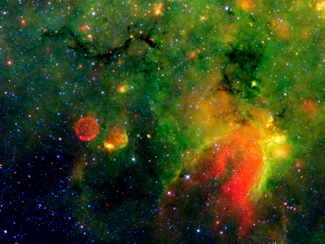
A Galactic Star Forming Region in Infrared
How do stars form? To help study this complex issue, astronomers took a deep
image in infrared light of an active part of our Milky Way Galaxy where star
formation is rampant. In IRDC G11.11-0.11, thick clouds of dust and gas are
congealing into stars that are so dark that humans living there would see an
empty night sky. The image, though, taken last year by the Spitzer Space
Telescope in infrared light, shows vast glowing fields of gas and dust,
indicating that much of this dust is heated by forming stars. The centers of
some clouds, such as the snake-like structure on the upper left, are so thick
and cold that they are dark even in infrared light. Many of the red dots are
glowing dust shrouds centered on very young newly formed stars. The unusual red
sphere below the snake is actually a supernova remnant, the glowing shell of a
young star so massive it evolved rapidly and exploded. The region spans about
150 light years and lies about 10,000 light years away toward the constellation
of Sagittarius.